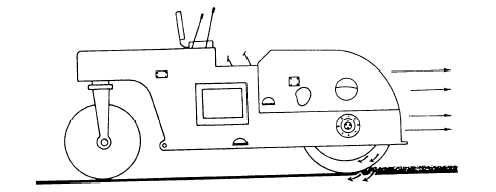Figure 11-44.-Steel-wheeled roller.
Figure 11-45.—Drive wheel rolling action.
Pneumatic-tired rollers may be equipped with 15-,
17-, 20-, or 24-inch tires. Air pressure in the tires may
vary for different types of material, such as 50 to 60 psi
to finish asphalt and 100 psi to compact a granular
subbase. The tires must be inflated to nearly equal
pressure with variation not exceeding 5 psi to apply
uniform pressure during rolling.
coarse materials and asphalt. This roller produces a
smooth, solid surface under favorable conditions, but
may fail to compact areas narrower than the roll, and do
not compact deeply in proportion to their weight. The
steel- wheeled roller does not change shape to bring
suitable support for itself. Rather it sinks until enough
bearing area has come in contact with the roll to support
Figure 11-43 shows the action of a pneumatic-tired
the roller weight.
roller. Pneumatic-tired rollers are used because the
The drive wheel is ahead of the tiller wheel in the
individual wheels can exert a kneading action in small
direction of travel. The tiller wheel functions as the
areas that wide, rigid steel drums tend to bridge.
steering axle. As shown in figure 11-45, there is a
STEEL-WHEELED ROLLERS
A steel-wheeled roller, as shown in figure 11-44, is
used for compaction and finish operations on base
downward vertical force caused by the weight or the
wheel. The arrows, concentric with the steel wheel,
represent the rotational force on the wheel. This force is
transmitted to the base of the wheel, as the roller is
11-23



